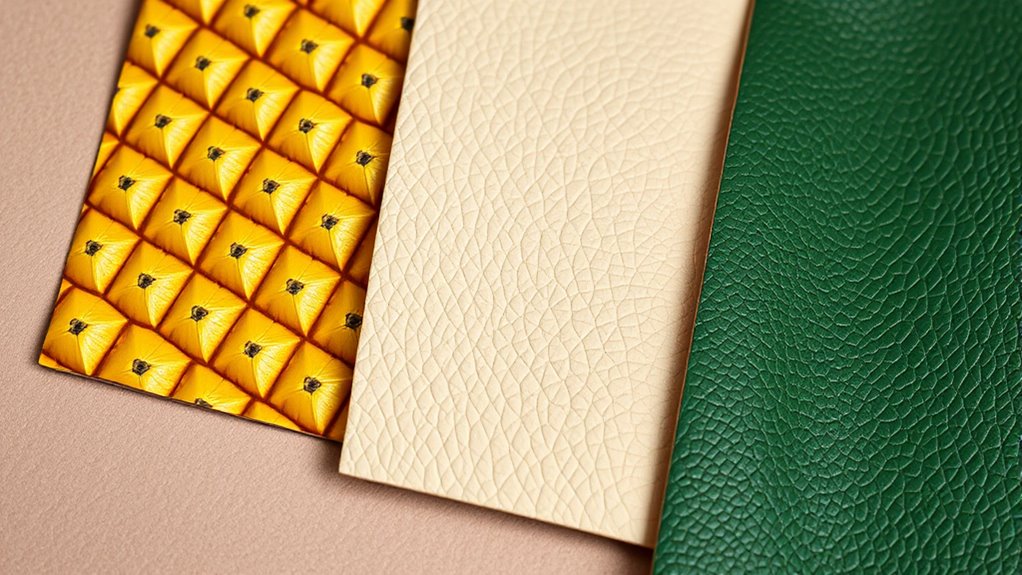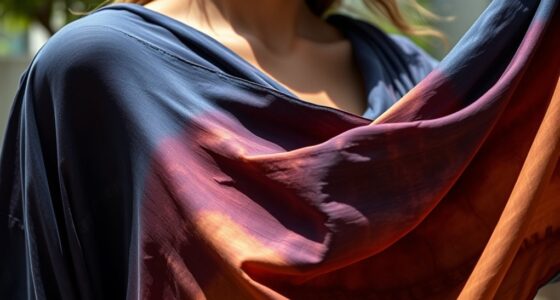Choosing the most eco-friendly vegan leather depends on your priorities. Pineapple leather uses agricultural waste, requires minimal water, and supports local communities, making it very sustainable. Mushroom leather grows rapidly with low resource needs, reducing land and water impact. Cactus leather is durable, needs little water, and is easy to integrate into manufacturing. If you want a lightweight, waste-reducing option, pineapple stands out, but explore more to find which suits your values best.
Key Takeaways
- Mushroom leather offers rapid growth, low resource use, and high scalability, making it highly sustainable for large-scale production.
- Pineapple leather excels in reducing agricultural waste and supports local farming communities, promoting circular economy benefits.
- Cactus leather requires minimal water, no pesticides, and is highly resource-efficient, making it an eco-friendly choice.
- All three materials are cruelty-free alternatives, but mushroom leather closely mimics traditional leather’s look and feel.
- The best choice depends on sustainability priorities: mushroom for scalability, pineapple for waste reduction, or cactus for resource efficiency.

As more people seek sustainable fashion options, vegan leather has become a popular alternative to traditional animal-based materials. You might wonder what sets the different types apart and which one truly offers the best sustainability benefits. When comparing pineapple, mushroom, and cactus leather, it’s clear that each brings unique advantages, but their impact on the fashion industry varies considerably.
Pineapple leather, known as Piñatex, is crafted from pineapple leaf fibers, turning agricultural waste into a stylish material. This process reduces waste, conserves resources, and supports local farming communities. Its sustainability benefits are notable because it requires minimal water and energy, making it an eco-friendly choice. The fashion industry impact here is positive, as brands can incorporate a biodegradable, cruelty-free material without compromising style. Plus, the production process encourages the reuse of waste products, aligning well with circular economy principles.
Pineapple leather, or Piñatex, transforms agricultural waste into stylish, eco-friendly, cruelty-free material supporting sustainability and local communities.
Mushroom leather, or mycelium-based leather, is made from fungi that grow rapidly and require little land or water. Its fast-growing nature means it offers impressive sustainability benefits—less land use, reduced water consumption, and a lower carbon footprint compared to traditional leather. Its production also involves fewer toxic chemicals, which is better for the environment. When you consider the fashion industry impact, mushroom leather stands out because it can be produced at scale and mimics the look and feel of natural leather. This makes it appealing for designers aiming to create luxurious, animal-free products while reducing environmental harm.
Cactus leather, or “Cactus Leather,” uses the thick skin of prickly pear cacti, which naturally shed and regenerate. This fast-growing plant needs little water and no pesticides, making it highly sustainable. Its sustainability benefits include resource efficiency and minimal environmental impact. The impact on the fashion industry is considerable because cactus leather can be easily integrated into existing manufacturing processes, providing a cruelty-free alternative that’s durable and versatile. Its natural resilience means it’s suitable for a wide range of fashion items, from shoes to handbags, helping brands meet the increasing demand for eco-conscious products. Additionally, innovations in AI-driven analytics are helping optimize sustainable material production, further enhancing the environmental benefits of cactus leather.
Frequently Asked Questions
How Do Vegan Leathers Compare in Environmental Impact?
When comparing vegan leathers’ environmental impact, you should consider sustainability metrics and raw material sourcing. You might find that pineapple leather uses agricultural waste, reducing waste, while mushroom leather grows quickly with minimal resources. Cactus leather requires less water than traditional materials. Each type has unique benefits, but overall, they tend to have lower environmental footprints than conventional leather. Your choice depends on sustainability priorities and raw material impacts.
Are Vegan Leathers Durable Enough for Everyday Use?
You might wonder if vegan leathers are durable enough for daily wear. Generally, they offer good material flexibility, allowing for comfortable, flexible footwear and accessories. While some may be more prone to scratching or wear over time, advances in manufacturing improve their longevity. Plus, they provide impressive aesthetic variety, so you can find stylish options that meet your everyday needs without sacrificing durability or appearance.
Which Vegan Leather Is Most Cost-Effective Long-Term?
When choosing the most cost-effective vegan leather long-term, you should consider the cost comparison and price stability. Pineapple leather tends to be more affordable initially, but its durability might affect its longevity, impacting overall value. Mushroom leather often costs more upfront but offers greater durability, ensuring stable prices over time. Cactus leather falls somewhere in between, balancing affordability and durability. Your choice depends on balancing initial costs with long-term value.
Can Vegan Leathers Be Recycled or Repurposed Easily?
Imagine a future where your eco-conscious choices bloom. Vegan leathers face recycling challenges, as their layered structures and unique materials can complicate traditional processes. Yet, they hold promising repurposing potential, turning once-used items into new creations with care. You can help by choosing brands dedicated to sustainable disposal methods, ensuring your vegan leather pieces find new life rather than ending up as waste. Your mindful actions make a difference.
Do Vegan Leathers Require Special Maintenance or Cleaning?
You don’t need special cleaning techniques or extensive maintenance tips for vegan leather. To keep it looking its best, simply wipe it with a damp cloth and mild soap when needed. Avoid harsh chemicals and excessive water, as these can damage the material. Regular cleaning and gentle care help maintain its appearance and durability, making vegan leather a practical and eco-friendly choice that’s easy to care for in everyday use.
Conclusion
Ultimately, choosing your vegan leather is like selecting a path through a lush, unpredictable forest. Pineapple, mushroom, or cactus—they each symbolize resilience, innovation, and sustainability. Your choice reflects not just a material, but your commitment to nurturing the earth’s delicate balance. As you walk forward, remember that every step you take on this journey echoes a promise: to protect and preserve, turning your decision into a seed that blooms into a greener, more compassionate future.









